Intel Core i7 3960X (Sandy Bridge E) Review: Keeping the High End Alive
by Anand Lal Shimpi on November 14, 2011 3:01 AM EST- Posted in
- CPUs
- Intel
- Core i7
- Sandy Bridge
- Sandy Bridge E
Gaming Performance
Most games have a tough enough time stressing more than four cores, so the move to the 3960X won't do much for gaming in most cases (particularly when GPU bound). That being said, the added cache may help give SNB-E a slight bump over its quad-core brethren.
Civilization V
Civ V's lateGameView benchmark presents us with two separate scores: average frame rate for the entire test as well as a no-render score that only looks at CPU performance.

In GPU bound scenarios the 3960X is no different than the 2600K. Civ V is a unique game in that its CPU workload does scale reasonable well across multiple cores:
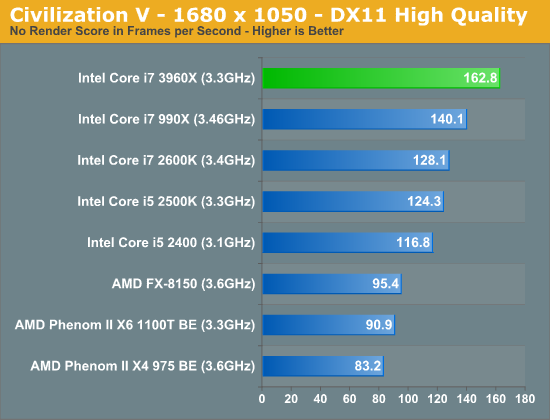
Here the 3960X is nearly 30% faster than the 2600K.
Crysis: Warhead
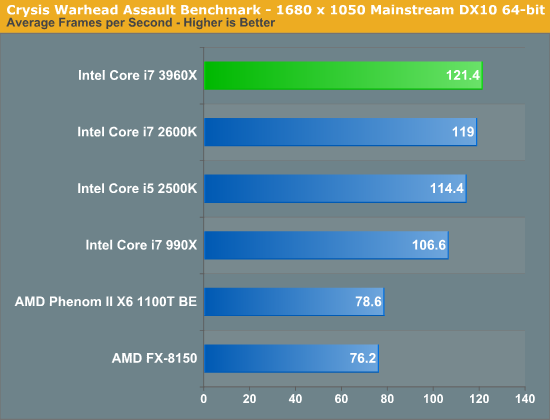
Dawn of War II
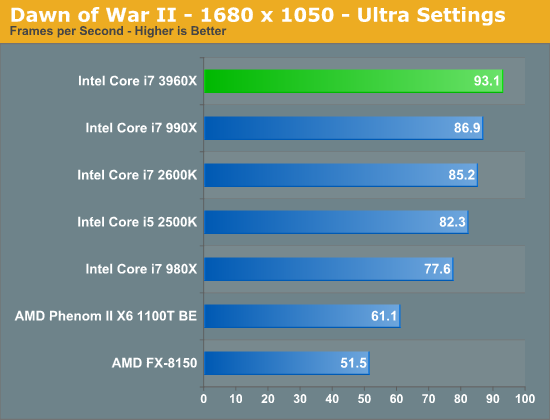
The larger cache helps give the 3960X a 9% advantage over the 2600K in Dawn of War II. At 1680 x 1050 the game isn't entirely GPU bound on our 5870.
DiRT 3
We ran two DiRT 3 benchmarks to get an idea for CPU bound and GPU bound performance. First the CPU bound settings:

DiRT 3 is an example of a CPU bound title (at lower resolutions) that doesn't scale well with core count or cache size. The 3960X is barely 2% faster than the 2600K.
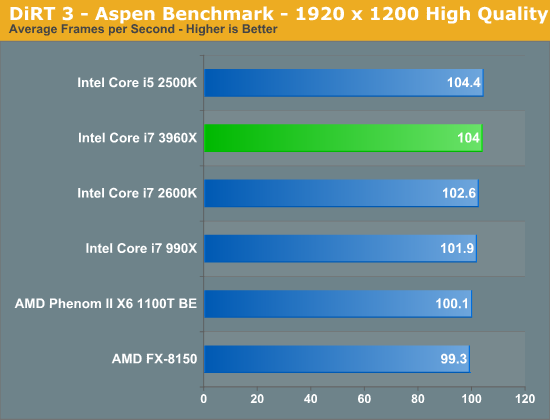
Metro 2033
It is interesting to note that while SNB-E and SNB perform similarly here, both parts do offer a performance improvement over the Gulftown based 990X.
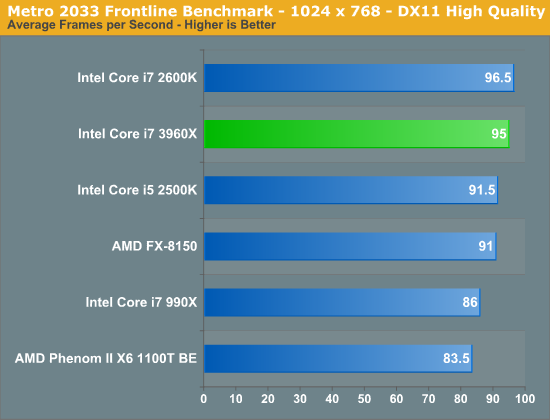
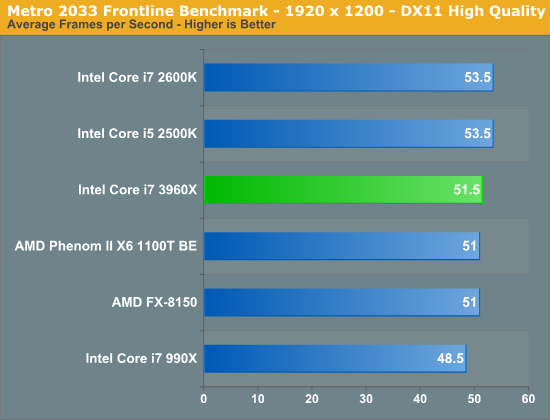
Rage vt_benchmark
While id's long awaited Rage title doesn't exactly have the best benchmarking abilities, there is one unique aspect of the game that we can test: Megatexture. Megatexture works by dynamically taking texture data from disk and constructing texture tiles for the engine to use (note that Rage doesn't store textures in a GPU-usable format). As a result whenever you load a texture, Rage is transcoding the texture on the fly. This is normally done by the CPU.
The Benchmark: vt_ are all the virtual texture commands. Vt_benchmark flushes the texture cache and then times how long it takes to transcode all the textures needed for the current scene, from 1 thread to X threads. Thus when you run vt_benchmark 8, for example, it will benchmark from 1 to 8 threads (the default appears to depend on the CPU you have). Since transcoding is done by the CPU this is a pure CPU benchmark. I present the best case transcode time at the maximum number of concurrent threads each CPU can handle:
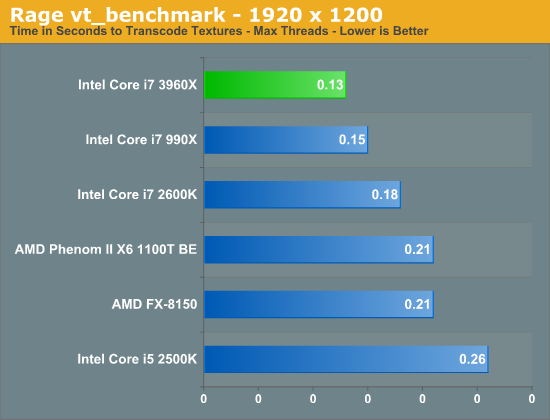
Starcraft 2
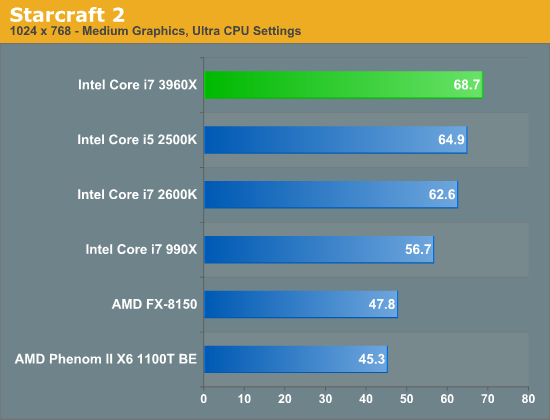
World of Warcraft
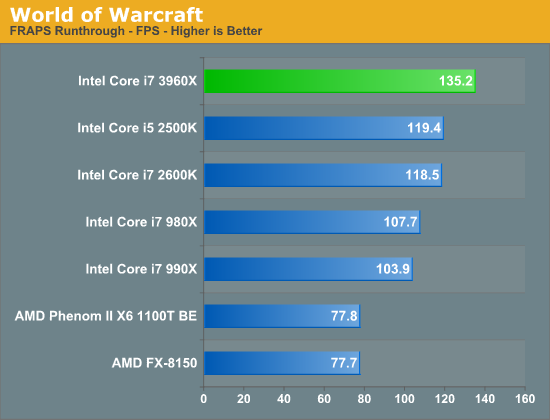
WoW does enjoy the 3960X's larger cache, here we see a 13% increase in performance compared to the regular Sandy Bridge parts.










163 Comments
View All Comments
JlHADJOE - Tuesday, November 15, 2011 - link
On Page 2, 'The Pros and Cons':> Intel's current RST (Rapid Story Technology) drivers don't support X79,
Rapid Storage, perhaps?
jmelgaard - Tuesday, November 15, 2011 - link
Computers are only getting faster one way today, and that is more cores, designing for up to a strict number of cores is merely stupidity in today's world.That said, developing games that support multiple cores might be somewhat more difficult than designing highly concurrent applications that processes data or request for data. (I can't say for sure as I have only briefly touched the game development part of the industry, but I work with the other part on a daily basis)
But while you might save development cost right now going down that road, you will spent the savings ones you suddenly have to think 8 cores in.
Carrying technical debt is never a good thing (And designing with a set number of cores in mind can to my programming experience only add that), it will only get more expensive to remove down the road, that has been proven to be true again and again.
And that is even considering that Frostbite 3 might be developed from the ground up, they still have to think up the concept again, while had they gone for high concurrency, then that concept would already be in place for the next version.
TC2 - Tuesday, November 15, 2011 - link
note,BD 4x2bc ~ 2B elements, 315mm2
SB-E 6x2hc ~ 2.27B elements ~ +14%, 435mm2 ~ +38% (includes unused space for 2 more cores), up to 15MB cache, ...
impressive at all!
C300fans - Tuesday, November 15, 2011 - link
Intel Gulftown 6C 32nm 6 1.17B 240mm2Intel Sandy Bridge E (6C) 32nm 6 2.27B 435mm2
I dont see any impressive thing. any performance improves?
Blaster1618 - Tuesday, November 15, 2011 - link
Given QPI @ 3.2 Ghz 205 Gb/s (25.6 GB/s) also handled the PCI load, can't we have something in the middle. I'm still a little confused is DMI 2.0 still just mainly simple parallel interface where QPI is a high speed series interface?C300fans - Tuesday, November 15, 2011 - link
Just imagine DMI 1.0 is a 4pcs pci-e 1x 1.0.DMI 2.0 is a 4pcs pci-e 1x 2.0
jmelgaard - Tuesday, November 15, 2011 - link
Clearly you didn't read a single of my points, or simply lack the understanding.Applications are not developed to target specific cores, you OS handles all that, it is a simple matter of pushing out jobs in threads or processes.
Processing in 10, 100 or 1000 threads/processes is no more difficult than doing it in 4... it just requires you have enough "JOBS" to process (and that term was deliberately chosen)...
This requires a different mindset though, and this might be more difficult to think of games that way right now, mostly because they have been use to running everything in that single game loop, but doing it now could be a rather good ROI down the road.
DarkUltra - Tuesday, November 15, 2011 - link
How about overclocking with turbo boost enabled? I mean, if the 3960X is stable at 4.4GHz, can it be stable at 4.8GHz when games or applications only use four cores? Then it would overclock and perform as good as a 2600K with four heavy threads.yankeeDDL - Tuesday, November 15, 2011 - link
Guys, there are always people with more money than brain that will purchase just about anything.That's not the point. Having the fastest CPU makes it a status symbol and whoever makes it can have the luxury to price it in the $1000 range, for fools to buy.
I don't know about CPUs, but I do know that the top performing GPUs (HD6990 and GTX590) are sold in extremely low volumes, both because of the relatively low ROI, both because the market is so little that inventory are scarce to begin with.
So, you may be right on the CPU side, but in general, you're both wrong.
This said, my point was that if AMD had performed and delivered a good CPU, instead of the FX8150, OR, the FX8150 at a good price point ($170, not $279), then Intel would have had a tougher time in pushing out the 3960X for this price, AND, it would have had to work harder on the chipset. However, because of the huge lead it has over AMD, Intel now can comfortably rebrand a "mid range" chipset and shove it to the customer who has no choice but take it if they want the best CPU.
retoureddy - Wednesday, November 16, 2011 - link
I agree on the fact that only 2 6GB SATA ports are a disappointment. Interesting though is to run two SSD in RAID 0 on the intel controller. With two Kingston SSD I manage real good figures (Crystal Disk Mark) : 4000MB test -> 1040MB/s Read and 621MB/s Write in (SEQ) / 675 and 481 (512K) / 28 and 253 (4K) / 279 and 405 4K QD32. I never managed this kind of throughput on the Z68 or P67 on-board controllers. These numbers are getting close to hardware RAID controllers like ARECA and LSI. I would have been interested to see where the bottleneck lies if X79 would have had more ports. Even though X58 is 3GB Sata you had no problem bottle-necking the Intel RAID controller at around 800MB/s.